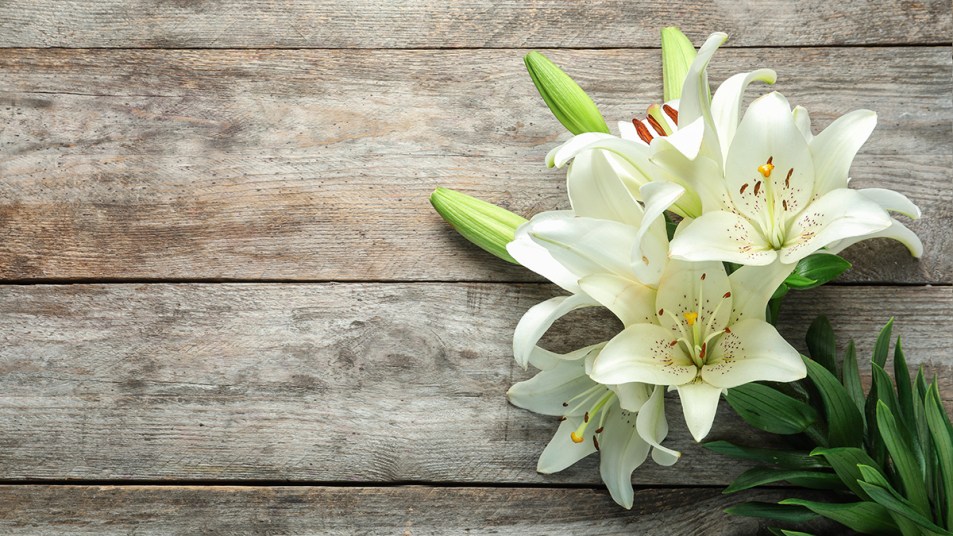Why You Should Never Send White Lilies To Someone in the Hospital — and Other Things to Know About Flower Color Meanings
There are a few things you definitely don't want to get wrong.

You already know that sending a bouquet of fresh flowers is a thoughtful gesture — they’re fragrant, colorful and beautiful, so of course they make a great gift. But did you know that the color of the flowers you give have specific meaning? That’s right — you might be communicating sympathy, friendship or even passionate romance with the stems you send… whether you mean to or not. So when picking out flowers for Valentine’s Day, sending an arrangement for a funeral, or creating the perfect bridal bouquet, it’s useful to know what each flower color represents and how you can use them to send the right message. Here’s a closer look at flower color meanings and how you can become fluent in the language of flowers.
White Flowers for Beginning and Endings
White flowers, like white roses or orchids, can be found at important life events, like weddings, funerals, and baby showers, notes Cathy Herrold, owner of Graci’s Flowers and Gifts in Pennsylvania. “White is associated with purity, thoughtfulness, and honesty.” However, it’s important to recognize that this sentiment may vary depending on where you are in the world. In many Asian cultures, for example, white is associated with death and should be avoided for weddings and baby showers. The type of flower is important, too. Lilies are beautiful white flowers, but they have Biblical associations with death and grief. Because of this, Herrold suggests skipping the lilies when picking out flowers to send to someone in the hospital or recovering from illness and instead opting for bright, cheery-hued blooms that will lift their spirits.
Orange Flowers for Next Steps
Orange flowers, like marigolds, zinnias, and tulips, are associated with joy, warmth, and optimism, making them a great option for friends in recovery, notes Herrold. They’re used to send the message of hope and happiness and can help to brighten up any room. If you’re in a relationship, however, they have a slightly different meaning, especially if they’re orange roses. Orange roses mean you’re looking to take the relationship further, whether that means becoming a couple, moving in together, or even renewing your vows. Sharing orange roses with a partner can be a subtle way to let them know that you’re ramping up to ask something big, since they represent boldness and enthusiasm, but also passion and desire.
Yellow Flowers for Friendship
Yellow flowers like daisies or yellow roses have long been associated with friendship. Their bright color symbolizes joy and gratitude. A few examples of sunny yellow flowers you can share with friends include sunflowers, daffodils, and chrysanthemums, depending on the time of year. Because they’re so cheery, yellow flowers can also be a great option for celebrating special occasions, like birthdays, graduations, or even new babies. If you think a loved one would appreciate the bright touch, yellow flowers can even be used to cheer someone up after injury or illness.
Peach Flowers for Gratitude
Another good option for saying “thank you”: “An arrangement of peach flowers, like amaryllis, tulips, and alstroemerias,” says Herrold. Peach flowers are sweet and feminine, and are typically associated with modesty, sincerity, and gratitude. They can be used in professional situations to express thanks after a business meeting or partnership development. A bouquet of peach flowers can make a lovely gift for the host at the next dinner party or to welcome guests into your home. They can also be sent as sympathy flowers if you don’t want to send a plain white arrangement.
Pink Flowers for Family
What’s not to love about classic pink flowers like carnations or orchids? Like peach flowers, pink flowers can be associated with femininity, happiness, and even sweetness or gentleness. They represent love, but less intimately than red flowers do, and they are a popular choice to symbolize love for family or friends. “Because of this, pink flowers are often given at Mother’s Day or other family events,” notes Herrold. Pink also symbolizes a more innocent type of romantic love, so pink flowers are a good choice for younger couples to use to share their affection. Keep in mind, however, that the hue of pink you choose is also important. Dark or bright pink flowers mean appreciation and gratitude and may speak to the importance of the connection you share with the recipient. Lighter pink flowers lean more toward sweetness and refinement. You’ll find romantic love in the middle, like with pink roses.
Red Flowers for Passion
When we think of red flowers, we typically think of red roses, and for good reason. Red flowers, be it roses, poppies, or tulips, are associated with love and passion, which is why it’s not unusual to send a dozen red roses to a lover or partner on a special day, says Herrold. Red also has another meaning when it comes to flowers — respect and courage. A bouquet of red flowers may be appropriate for a friend experiencing a new beginning or journey. Just be aware that red flowers, especially red roses, are more closely associated with romance, so send them with caution to avoid miscommunication.
Lavender Flowers for Love
When we hear lavender, we likely think of the lavender flower — and for good reason. “Both the color and the flower itself represent serenity and calmness,” says Herrold. Because purple is a color that has long been used to represent royalty, lavender flowers are also associated with royal traits, such as elegance and luxury. In a relationship, lavender-colored flowers like lilacs and hyacinths can be quite daring, since they may represent love at first sight. If you’re looking to show someone you’re interested or reinforce your emotions in a long-term partnership, a lavender-colored flower is the perfect choice.
Dark Purple Flowers for Graduations
“Dark purple flowers are associated with royalty and elegance, similar to lavender flowers,” notes Herrold. They are often used to symbolize success and admiration, and may be an appropriate gift for a mentor at a special event like graduation. Similarly, dark purple flowers are associated with respect and power, so you’re sure to send a strong message when you gift purple flowers or bring them into your home.
Blue Flowers for Sympathy or Yearning
Like the lighter purple flowers, blue flowers are associated with a sense of peace and calm, largely because blue flowers tend to be lighter or softer in color. Some of the most common blue flowers are hydrangeas (which can also be pink or purple, depending on the pH level of your soil), forget-me-nots, and bluebells. Many wildflowers that bloom at the start of spring are also blue in color. “Because blue flowers can imply peace and serenity, they are a great choice to send to someone who may be experiencing stress,” suggests Herrold. One note: Darker blue flowers, like blue roses, can be associated with romance, but more often represent unrequited love, so consider the recipient carefully.
Putting Your New Knowledge of Flower Color Meaning to Work
Every flower and bouquet tells a story and allows us to communicate with friends, family, and romantic partners without saying a word. Both the flower’s type and color can mean a great deal. “By choosing the perfect colors for a bouquet, you can evoke a certain positive emotion and feeling for the person receiving it whether it be joy, tranquility, or gratitude,” explains Herrold. When sending sympathy bouquets, white, light pink, or light blue flowers are best. You’ll want to skip lilies for get-well flowers and stick to some of the brighter blooms, and there’s no better way to tell a friend you’re thinking of them than with a sunny yellow bouquet. Of course, you can’t go wrong with the classics to show love and romance, and a dozen red roses are the perfect symbol of love for Valentine’s Day or the next anniversary. You can even mix and match flowers to embrace the many facets of your important relationships. Now that you’ve learned more about the meanings behind your favorite flower colors, you can begin spreading floral love and friendship.













